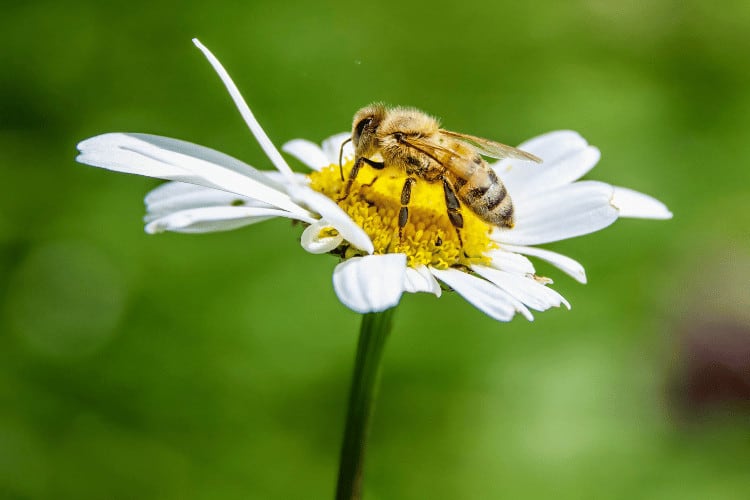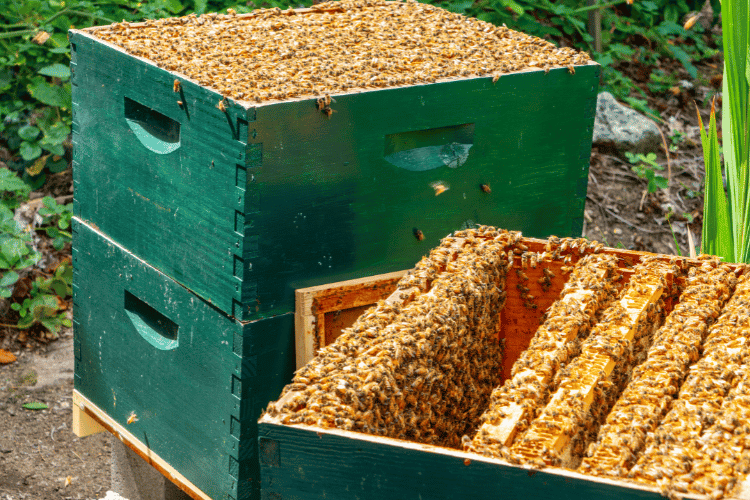Saskatraz Bees vs. Carniolan Bees: A Buzzing Comparison
If there’s one tiny creature that deserves a standing ovation, it’s the humble honey bee.
These hardworking insects play a vital role in pollinating our crops, ensuring a bountiful harvest, and providing us with that golden nectar we call honey.
In this article, I’m diving deep into the buzzing world of bee races to compare two popular contenders: Saskatraz bees vs Carniolan bees.
If you’ve ever wondered what sets these winged wonders apart, grab your beekeeper’s hat and join me as we unravel the tale of these remarkable insects!
An Overview of Saskatraz Bees

When you venture into the world of types of bees, you’ll notice that Saskatraz bees bear a striking resemblance to their Russian counterparts.
These North American honey bees sport a darker, more subdued coloration with fewer orange or yellow hues, and they often have lighter grey and brown stripes.
Similar to the Russian bees, their temperament leans towards the spirited side. While not quite as docile as Italian or Carniolan bees, Saskatraz bees are known for their mild yet noticeable aggression.
One fascinating trait that sets Saskatraz bees apart is their affinity for producing sufficient amounts of propolis, a sticky substance derived from plant resins.
These hearty bees are becoming increasingly available to beekeepers, although their price tag tends to be higher compared to Italian and Carniolan bees. They weather the winter months admirably, but their vigor can sometimes lead to swarming tendencies.
Saskatraz bees are known for their solid resistance against two formidable foes: varroa and tracheal mites. Their resilience to these common threats has solidified their reputation as one of the best honey bee races for beekeepers.
Advantages of Saskatraz Bees
- Varroa Mite Resistance: Saskatraz Queens are renowned for their impressive resistance to Varroa mites, a major threat to bee colonies worldwide.
- Propolis Production: Saskatraz bees are prolific producers of propolis, a valuable substance with various health benefits for bees.
- Availability: These bees are accessible to beekeepers; they’re easier to find than other races.
- Swarming Tendency: While their vigor is an advantage, it can also lead to increased swarming tendencies, which can be managed with proper hive management.
- Tracheal Mite Resistance: In addition to Varroa mites, Saskatraz bees have shown resistance to tracheal mites, contributing to colony health.
These benefits collectively make Saskatraz bees a compelling choice for beekeepers seeking a resilient and productive bee race.
An Overview of Carniolan Bees

Alongside the Italian honey bee, Carniolans stand as prominent choices offered by local distributors, owing to their steady demand.
Bearing a similar size to Italian honeybees, Carniolans display a distinct shade of gray. However, their gentle disposition, a hallmark of their tolerant traits, sets Carniolans apart, along with their wintering ability.
Carniolan colonies exhibit a fascinating adaptation to the environment—they restructure their population based on nectar availability.
When blossoms dwindle, they downsize their colony for the winter, requiring less stored honey. That’s why they can survive cold winters without a fuss.
Although they thrive in regions with prolonged winters, they tend to shy away from excessively hot summer days.
Carniolan honey bees exhibit an intriguing set of traits, such as an early start to foraging in the spring, prolific beeswax production, and gentle temperaments.
Choosing Carniolans becomes especially wise in regions with early winters. Their proactive foraging behavior grants them a head start, maximizing their time to gather resources.
However, this eagerness also means they might need extended spring feeding compared to Italians or Saskatraz bees.
Advantages of Carniolan Bees
- Early Brood Production: Carniolans kick off their brood production swiftly in early spring, ensuring a robust start to colony growth.
- Gentle Temperament: Their gentle disposition and minimal aggression make Carniolan bees a preferable choice for densely populated areas.
- Winter Endurance: These bees overwinter successfully, displaying resilience in the face of colder months.
- Disease Resistance: Carniolans boast a natural resistance to brood diseases, promoting the overall health of their colonies.
- Foraging Prowess: Carniolans have an extended foraging window, being active earlier and later in the day, even in wet conditions.
- Less Prone to Robbing: Their ability to defend their hives makes them less prone to robbing. They’ll famously attack parasites for the sake of keeping their hives safe.
These advantages collectively establish Carniolan bees as a well-rounded and adaptable choice, particularly suitable for beekeepers aiming for healthy, thriving colonies.
Saskatraz Bees Vs Carniolan: Choosing the Right Bee Race

When it comes to selecting the ideal bee race for your apiary, there are plenty of factors to consider.
Both Saskatraz and Carniolan bees bring unique traits to the hive, making the decision a matter of aligning their strengths with your goals.
For beginners dipping their toes into beekeeping waters, the gentle temperament of Carniolan bees can be a reassuring choice, especially in areas with denser populations.
On the other hand, those with experience might appreciate the resilience and varroa mite resistance that Saskatraz bees offer.
The decision also depends on the climate you’re in, as Carniolans deal with colder climates well, while Saskatraz bees have better adaptability to North American conditions—dry, humid weather.
In the end, it boils down to what you want: robust honey production, disease resistance, or simply a thriving colony.
Taking into account factors like local flora, management practices, and environmental conditions will steer you toward the bee race that can survive best in your area.
Conclusion
The choice between Saskatraz bees and Carniolan bees is far from a simple buzz. Each bee race weaves a distinctive thread into the tapestry of the hive, offering beekeepers a spectrum of qualities to consider.
